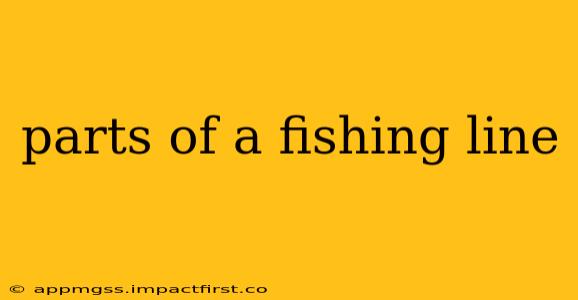Fishing line, seemingly simple, is a complex piece of equipment crucial to a successful fishing trip. Understanding its different parts and their functions is key to choosing the right line for your needs and improving your angling technique. This guide breaks down the components and provides insights into how each part contributes to the overall performance of your fishing line.
What are the main parts of a fishing line?
While there isn't a universally agreed-upon breakdown into distinct "parts" of fishing line in the same way a car has wheels and an engine, we can analyze its key characteristics and features. These aspects contribute to its overall performance and are what anglers consider when selecting a line. We'll explore these "functional parts" in detail below.
1. The Core Material: The Foundation of Strength and Performance
The core material is the fundamental building block of your fishing line. This is the substance that gives the line its strength, durability, and other performance characteristics. Common core materials include:
- Nylon: A popular and versatile choice, nylon offers good strength, abrasion resistance, and stretch. Its stretch helps absorb shock when fighting larger fish.
- Fluorocarbon: Known for its low visibility in water, fluorocarbon boasts high strength-to-diameter ratio and excellent abrasion resistance. It's less stretchy than nylon.
- Braid/PE (Polyethylene): Extremely strong for its diameter, braided lines offer minimal stretch and excellent sensitivity, allowing you to feel even the slightest nibble. However, they can be more susceptible to abrasion than nylon or fluorocarbon.
2. The Coating (if applicable): Enhancing Durability and Performance
Many fishing lines, particularly monofilament (nylon) lines, feature a coating applied to enhance their properties. These coatings can improve:
- Abrasion Resistance: Protecting the line from damage caused by rocks, snags, and other underwater obstacles.
- Knot Strength: Improving the strength of knots tied in the line.
- UV Resistance: Protecting the line from degradation caused by prolonged sun exposure.
- Castability: Improving the smoothness and distance of your cast.
Some lines may use specialized coatings to boost specific attributes. Look for descriptions like “super smooth coating” or “abrasion-resistant coating” on packaging.
3. The Diameter/Test Strength: Balancing Sensitivity and Strength
The diameter of the line is a critical factor, closely tied to its test strength. Test strength refers to the breaking strength of the line—the amount of force it can withstand before breaking. A thinner diameter generally means lower visibility in the water but also less strength. The ideal balance depends on your target fish and fishing conditions.
4. The Color: Matching the Environment
The color of the fishing line can significantly impact its effectiveness. Clear lines are less visible in clear water, while darker lines may be better for murky or stained waters. Some lines are specifically designed with camouflage coloration to blend seamlessly with the environment.
5. The Length: Adapting to Fishing Situations
While not a physical "part," the length of your fishing line is an important consideration. The appropriate length depends on the fishing situation and method. You need enough line to reach your target depth, account for the distance of your cast, and handle the fight with a fish.
What are the different types of fishing line?
This question delves further into the core materials and their properties. We've already touched upon the main types: monofilament (nylon), fluorocarbon, and braided line (PE). Choosing the right type heavily depends on the type of fishing, the target species, and the fishing conditions.
How do I choose the right fishing line?
Selecting the right fishing line requires understanding the factors mentioned above. Consider:
- Target species: Larger, stronger fish require heavier lines with higher test strength.
- Fishing technique: Certain techniques, such as fly fishing, require specific line characteristics like low stretch and high sensitivity.
- Water clarity: Clear water calls for less visible lines, like fluorocarbon.
- Water conditions: Lines with higher abrasion resistance are better for rocky or weedy areas.
This guide provides a solid foundation for understanding the aspects of fishing line that contribute to its performance. Experimentation and experience will help you refine your understanding and find the perfect line for your specific fishing needs. Remember to always check the manufacturer’s specifications for detailed information on the line's properties and capabilities.
